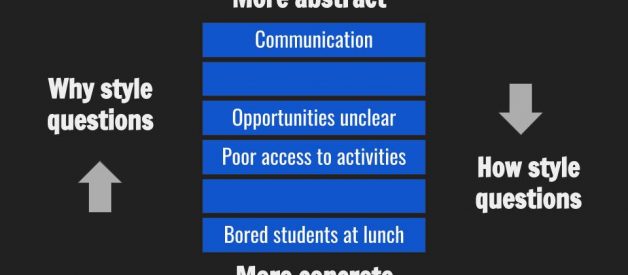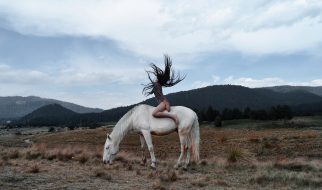A mental model that I frequently use is the Ladder of Abstraction. It was developed by the American linguist S. I. Hayakawa in his 1939 book Language in Action.
The model describes varying levels of abstraction (up) and concreteness (down) and helps describe our language and thoughts.
The higher up the ladder you are the more abstract the idea, language or thought is. The lower you are on the ladder the more concrete the idea, language or thought is.
You can also think about the ladder as scaling out (abstracting) and scaling back in (concrete). I often use the language:
Let?s zoom out for second. Why is this connected to other projects?
OR
What does this look like in the classroom? Zoom back into the day to day experience for me.
And of course, there is a parallel to the ideas of theory Vs experience.
It is helpful to note that different types of questions or interactions move dialogue up or down the ladder.

Let?s look at some simple examples based on developmental work in schools. The first few illustrate how you can use the ladder as a way to think about problem-solving. You can also use the 5 Whys mental model here.
*Remember that the ideas illustrated on the ladders below would each emerge during discussion and dialogue. Each idea might unfold as different questions are posed and pondered on.
The blue example below is simple enough to see it is a not a behaviour issue but a communication issue perhaps.
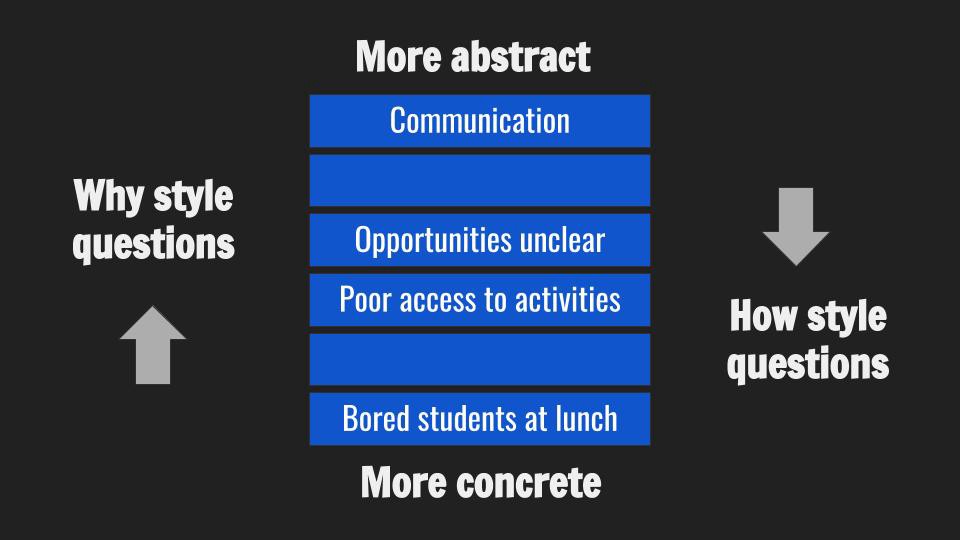
The green example suggests the link between report writing and staff wellbeing. It not just an assessment issue but something that might have a negative impact on health.
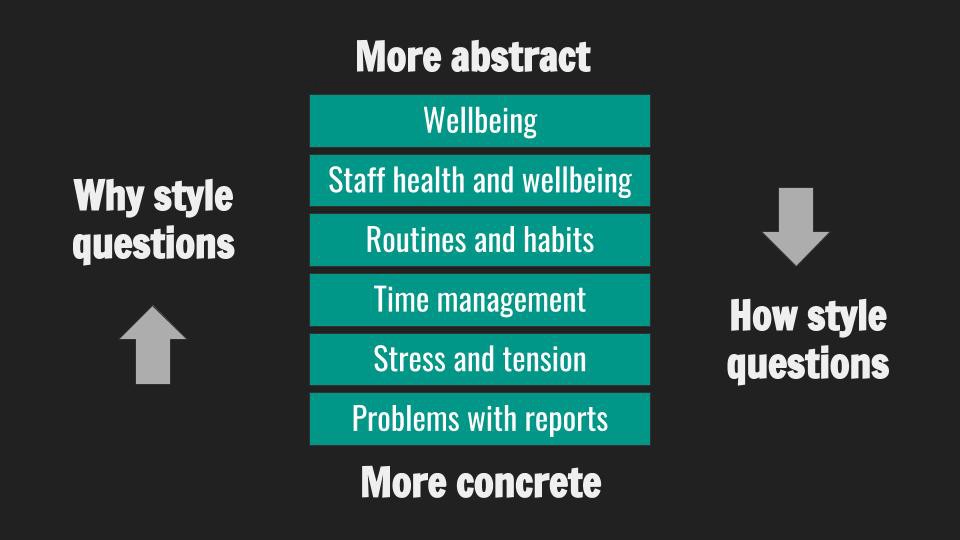
Yellow and purple below are slightly different as they might illustrate a more general use of the ladder. Not necessarily to understand the problem, as above, but to broaden our understanding of an idea.
When we ladder down into the concrete and back up into the abstract concept we have a much more rounded sense of the idea. This makes communication much more successful as you work both ends of the ladder.
Be mindful of which end you spend time in the most when working with your ideas or with your teams. Try and strike a balance.
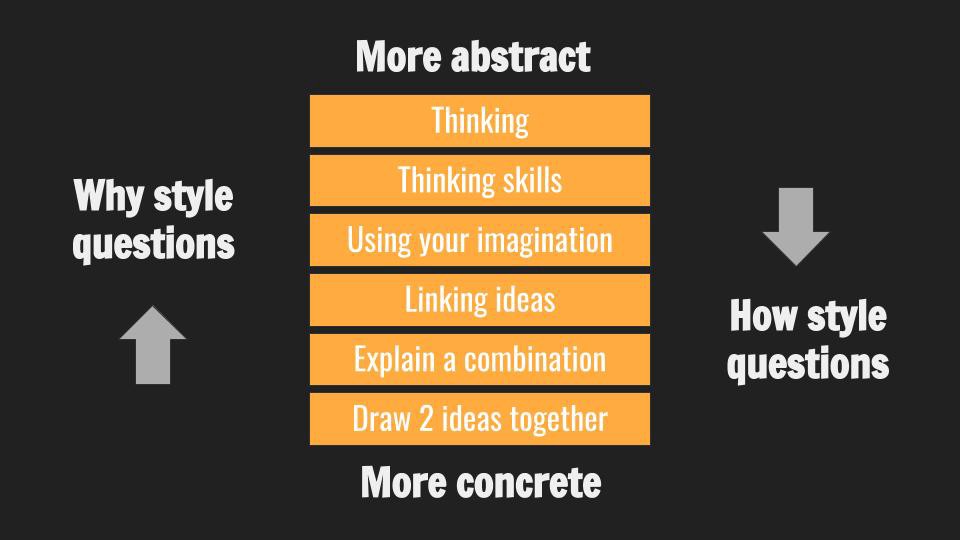
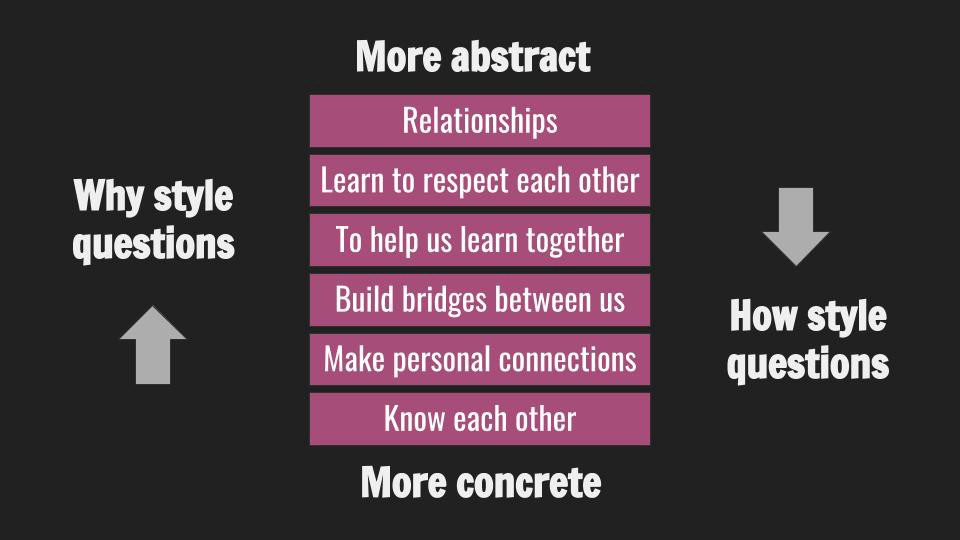
The Ladder of Abstraction is commonly used as a model for interviewing and I have used this many times during the design thinking process. As this piece from the d.school illustrates.
Often times abstract statements are more meaningful but not as directly actionable, and the opposite is true of more specific statements. That is why you ask ?why?? often during interviews ? in order to get toward more meaningful feelings from users rather than specific likes and dislikes, and surface layer answers.
So it is a great model for your design toolkit.
Take a look at these further thinking prompts to help you move in an agile way on the ladder, by Andrew Dlugan on the Six Minutes site. A great post that is well worth a read.
Moving Down the Ladder
- Embrace the phrase ?For example?? .Provide real-world tangible examples for your theories and ideas.
- Use sensory language.Help your audience see, touch, hear, taste, and smell.
- Be specific.Provide ample details.
- Tell stories and anecdotes.Stories add emotion and realism to any theory.
- Cite data, statistics, and case studies.They offer support for your theories.
- Feature photographs and props.Remember that all words are a higher level of abstraction compared to the real thing. Use the real thing.
- Have a strong call-to-action.Show your audience how to put your message into practice.
- Answer ?How?? questions.Questions like ?How does this work?? force you to more concrete explanations.
Moving Up the Ladder
- Answer ?Why is this important??Give the deeper meaning behind the concrete facts and data.
- Provide the big picture.Explain the context and orient your audience.
- Reveal patterns and relationships.Help your audience see how the ideas connect ? both to other ideas and their lives.
- Draw diagrams.Help your audience form mental models of processes, objects, etc.
- Use appropriate charts.Go beyond pure data to show trends.
- Reveal the lesson.Follow every story or case study with the key insights.
- Draw inferences.Apply sound logic to generalize from particular cases.
- Summarize into principles and guidelines.Help the audience learn from your experience by providing principles they can use.
- Appeal to shared ideals.Draw connections between your message and the ideals held by your audience, such as justice, truth, liberty, or freedom.
?
Let me know how you get on with this little model, a worthy addition to your toolkit. This is a core activity for me, something I keep coming back to again and again.
Emerging leaders often find this difficult as they have to step out of just thinking about their own classroom.
I firmly believe that the capacity to move up and down the Ladder of Abstraction is a key skill for any leader.
Some further reading:
Method 19 of 100: Laddering Questions | Designing the User Experience as Autodesk
How/Why Laddering | The K12 Lab Wiki | d.school
Abstraction Laddering: Clearly Define the Problem | Autodesk
The Ladder of Abstraction and the Public Speaker | Six Minutes
The Dialogic Learning Weekly ? Revue
Thousands of people just like you enjoy my weekly Friday missive exploring Leadership, Learning and Innovation. ?nobody?
newsletter.dialogiclearning.com
The Dialogic Learning Weekly
Thousands of people just like you enjoy my weekly Friday missive exploring Leadership, Learning and Innovation.
?nobody else shares such inspiring work on innovative education.?
?I look forward to my Friday email as it is always thought-provoking.?
?Not too long, not too short, just right!?
Consider it the Goldilocks of newsletters. Join us!
